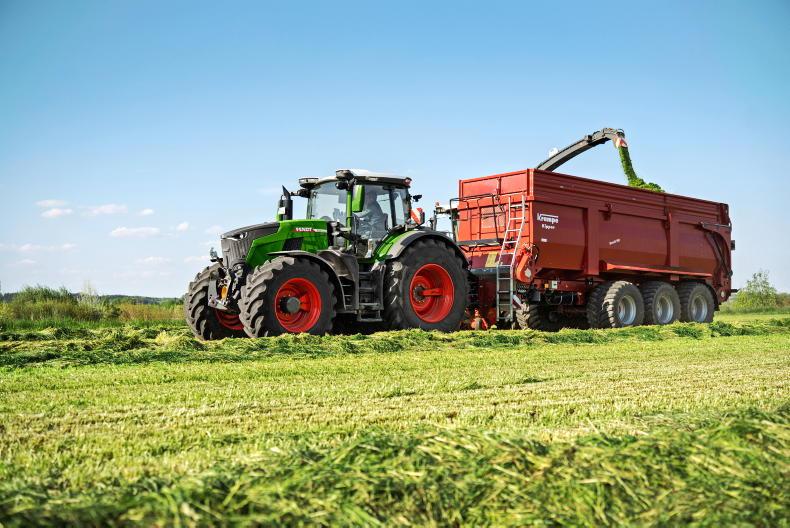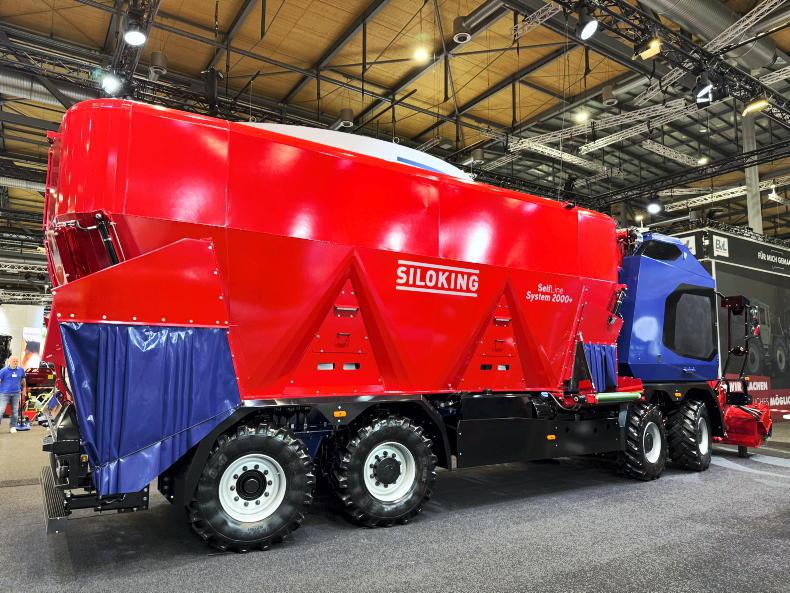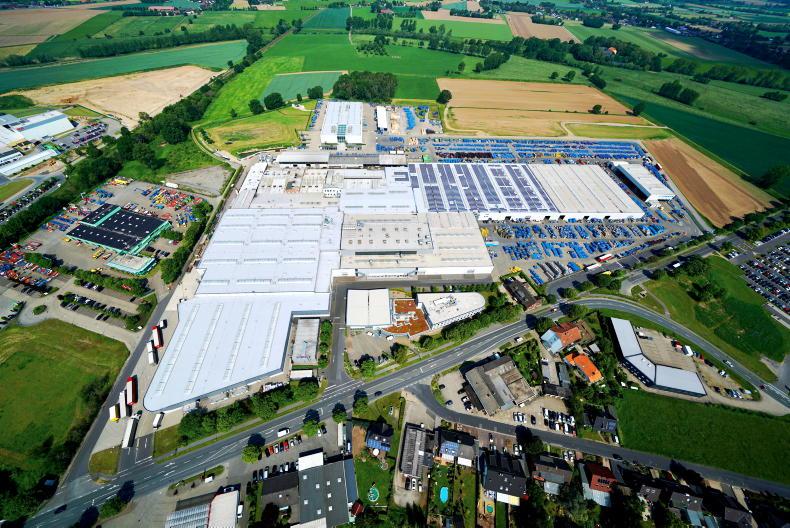The Valtra-Valmet 8950 is one of the most sought after tractors from the late 90s, early noughties era. The firm’s flagship tractor at the time, it was strongly favoured by tillage farmers and contractors. During its four-year production run (1999-2003), some 1,478 units of the 8950 were built at the company’s factory and headquarters in Suolahti, Finland.
Valtra-Valmet’s tractor offering has always been a little different to other manufacturers. It builds more tailor-made tractors to suit the end user, be that for farming, forestry or municipal applications. And then there is the choice of multiple colours, something the firm has taken a step further today with its Unlimited studio.

Production of the Valtra-Valmet 8950 spanned from 1999-2003 with a total of 1478 units built in its four year production run.
Forestry is a particular area its tractors were built to suit. All tractor undercarriages were flat, with 4WD prop shafts covered by the load-bearing fuel tank and chassis. All sensors and pipes are mounted on top of the transmission and the hitches are integrated into the tractor’s back-end, helping increase ground clearance and prevent the risk of damage from branches and tree stumps.
Other distinguishing features of the brand were its shorter wheelbase approach and 60:40 weight distribution for optimum performance in the field or forest, which some will argue had a negative effect on road travelling comfort. Reverse drive (TwinTrac) was a common sight, believed to have been fitted to over 20% of the 8950 models sold.
Valtra-Valmet fitted its tractors of the 90s and early noughties with larger displacement engines, regardless of power output. This may be a reason for the brand’s reputation of having the ability to clock up big hours with few issues. On the other hand, Valtra is today known as one of the leading brands at maximising horsepower output out of smaller-displacement four-pot engines.
A brief history
The Finnish manufacturer’s roots can be traced as far back as the 1830s, and it has been producing tractors since 1951, Valmet-Valtra was relatively unknown in Ireland and the UK until the early 1990s. Valtra was acquired by AGCO in 2004, bringing with it SISU Diesel, manufacturer of off-road diesel engines. SISU Diesel was rebranded as AGCO Power in 2008. Today, Valtra has manufacturing sites in Suolahti and Sao Paulo, Brazil.
The company has a long-standing pedigree, with an intriguing bloodline involving well-known names such as Valmet, Volvo, Munktells and Bolinder dating back to war times.
In 1979 Valmet bought the Volvo BM tractor business and by 1983 had become market leader in the Nordic countries.

Sigma Power introduced in 1996 was an automatic 30hp-40hp power boost for PTO applications.
Becoming Valtra
The Valmet name remained until 1994, when the reorganising of state-owned companies saw Valmet tractors become Sisu-Valmet. In January 1997, it became clear that Partek had bought Sisu-Valmet. The right to use the Valmet name was limited until 30 April 2001. Valtra was then born, with units from 1997 until 2001 branded as Valtra-Valmet to smooth the transition period. Valmet engines were also renamed Sisu Diesel.
When AGCO bought out Valtra in 2004 it was the first time it was owned by a company that operates in the same industry.
Irish debut
Valtra-Valmet made its first big Irish appearance at the 1994 National Ploughing Championships, and went on to have a lasting impact on the Irish market.
The number of 8950s believed to have been sold new in Ireland is low given that a 200hp tractor was big for the 1999-2003 era. The average horsepower tractor sold in the late 90s would have been more in the region of 100hp compared to the 150hp of today. This and the fact Valtra-Valmet were reasonably new to the Irish market would have resulted in lower numbers of new units registered.
However, over the years Valtra has grown its presence on the Irish market hugely for both new tractor sales as well as the number of used imports. Among these imports are the newer N and T series tractors as well as the older 6000 and 8000 series machines. Over the past number of years, the value of 8000 series tractors has been appreciating, with Irish and international buyers for any clean example regardless of hours, which in most cases exceed the 10,000 mark.
HiTech
The HiTech transmission was developed to be an electronically controlled multi-speed quick transmission. It offered users more electronics, arguably providing greater comfort. Features included an integrated left-hand shuttle lever and an integrated handbrake function. HiTech being an option across many 6000 and 8000 models; it was offered as standard on the 8950.
The 36x36 transmission comprised four manual gears, low, medium or high range changes and a three-speed ‘Delta’ powershift making up the total 36 forward and 36 reverse speeds. HiTech models were fitted with an electronic clutch button on the gear lever. The idea was to press the button and select the new gear. Two clutches were fitted on HiTech models, one for forward and one for reverse. These HiTech models had a forward reverse shuttle designed to work in extreme low temperatures.
HiTech models had three powershift modes – manual control, field mode or transport mode. Manual mode gave the operator full ability to control gear selection and powershifts. For field and transport modes, powershifts are automatically selected for max output or for a more economical performance, respectively.
HiTech models had a digital display on the front right pillar, which Valtra and other manufacturers still offer today albeit as a more standard approach. The display provided operators with information including travel direction, powershift mode, driving speed, temperatures and optimal gear selection in automatic powershift mode.

Valtra-Valmet 6000 series and 8000 series.
Sigma Power
Valmet introduced Sigma Power in spring 1996 in Paris. Although common across many manufacturers today, power boosting was pretty much unheard of in the 90s. Sigma Power provided an automatic 30hp-40hp power boost for PTO applications. At the time the Mega 50 series was introduced, with the Valtra-Valmet 8750 being the flagship model. The 8750 had a rated power of 160hp, but when 250Nm of torque was measured through the PTO, the tractor’s ECU increased engine power to 190hp. Similar to the 8950, it boosted from 160hp to 200hp. The two power levels were controlled by the boost pressure of the turbocharger (this changed depending on load on the engine which in turn changed depending on PTO load). A light on the dashboard showed “ETB” and the LED on the dashboard showed how much of the power was being used.
Valtra-Valmet received a DLG gold award at Agritechnica in 1997 for the Sigma Power innovation. More than 10,000 Sigma Power tractors have been built since at the Valtra Suolahti factory.
Being one of the first boost systems on the market, it was easily tweaked, with many tractors fitted with a 30/40hp bypass switch. This meant that the operator could get the hp boost irrespective of PTO load. Many machines were tweaked and running in the region of 220-230hp. This offered an even higher power-to-weight ratio on particular Sigma Power models.
The spec
?Model: Valtra-Valmet 8950 HiTech specs
Engine: 7.4L six-cylinder Valmet turbo with Sigma power
Max power: 160-200hp @ 2200rpm; 820Nm 1400rpm
Transmission: 36 x 36 semi-powershift, 40km/h standard
Weight: 5,220kg
Rear lift capacity: 6,899kg
Wheelbase: 495cm
Fuel tank capacity: 250l
Hydraulic pump flow: 73l/min
Production run: 1999-2003
Units built: 1478
The Valtra-Valmet 8950 is one of the most sought after tractors from the late 90s, early noughties era. The firm’s flagship tractor at the time, it was strongly favoured by tillage farmers and contractors. During its four-year production run (1999-2003), some 1,478 units of the 8950 were built at the company’s factory and headquarters in Suolahti, Finland.
Valtra-Valmet’s tractor offering has always been a little different to other manufacturers. It builds more tailor-made tractors to suit the end user, be that for farming, forestry or municipal applications. And then there is the choice of multiple colours, something the firm has taken a step further today with its Unlimited studio.

Production of the Valtra-Valmet 8950 spanned from 1999-2003 with a total of 1478 units built in its four year production run.
Forestry is a particular area its tractors were built to suit. All tractor undercarriages were flat, with 4WD prop shafts covered by the load-bearing fuel tank and chassis. All sensors and pipes are mounted on top of the transmission and the hitches are integrated into the tractor’s back-end, helping increase ground clearance and prevent the risk of damage from branches and tree stumps.
Other distinguishing features of the brand were its shorter wheelbase approach and 60:40 weight distribution for optimum performance in the field or forest, which some will argue had a negative effect on road travelling comfort. Reverse drive (TwinTrac) was a common sight, believed to have been fitted to over 20% of the 8950 models sold.
Valtra-Valmet fitted its tractors of the 90s and early noughties with larger displacement engines, regardless of power output. This may be a reason for the brand’s reputation of having the ability to clock up big hours with few issues. On the other hand, Valtra is today known as one of the leading brands at maximising horsepower output out of smaller-displacement four-pot engines.
A brief history
The Finnish manufacturer’s roots can be traced as far back as the 1830s, and it has been producing tractors since 1951, Valmet-Valtra was relatively unknown in Ireland and the UK until the early 1990s. Valtra was acquired by AGCO in 2004, bringing with it SISU Diesel, manufacturer of off-road diesel engines. SISU Diesel was rebranded as AGCO Power in 2008. Today, Valtra has manufacturing sites in Suolahti and Sao Paulo, Brazil.
The company has a long-standing pedigree, with an intriguing bloodline involving well-known names such as Valmet, Volvo, Munktells and Bolinder dating back to war times.
In 1979 Valmet bought the Volvo BM tractor business and by 1983 had become market leader in the Nordic countries.

Sigma Power introduced in 1996 was an automatic 30hp-40hp power boost for PTO applications.
Becoming Valtra
The Valmet name remained until 1994, when the reorganising of state-owned companies saw Valmet tractors become Sisu-Valmet. In January 1997, it became clear that Partek had bought Sisu-Valmet. The right to use the Valmet name was limited until 30 April 2001. Valtra was then born, with units from 1997 until 2001 branded as Valtra-Valmet to smooth the transition period. Valmet engines were also renamed Sisu Diesel.
When AGCO bought out Valtra in 2004 it was the first time it was owned by a company that operates in the same industry.
Irish debut
Valtra-Valmet made its first big Irish appearance at the 1994 National Ploughing Championships, and went on to have a lasting impact on the Irish market.
The number of 8950s believed to have been sold new in Ireland is low given that a 200hp tractor was big for the 1999-2003 era. The average horsepower tractor sold in the late 90s would have been more in the region of 100hp compared to the 150hp of today. This and the fact Valtra-Valmet were reasonably new to the Irish market would have resulted in lower numbers of new units registered.
However, over the years Valtra has grown its presence on the Irish market hugely for both new tractor sales as well as the number of used imports. Among these imports are the newer N and T series tractors as well as the older 6000 and 8000 series machines. Over the past number of years, the value of 8000 series tractors has been appreciating, with Irish and international buyers for any clean example regardless of hours, which in most cases exceed the 10,000 mark.
HiTech
The HiTech transmission was developed to be an electronically controlled multi-speed quick transmission. It offered users more electronics, arguably providing greater comfort. Features included an integrated left-hand shuttle lever and an integrated handbrake function. HiTech being an option across many 6000 and 8000 models; it was offered as standard on the 8950.
The 36x36 transmission comprised four manual gears, low, medium or high range changes and a three-speed ‘Delta’ powershift making up the total 36 forward and 36 reverse speeds. HiTech models were fitted with an electronic clutch button on the gear lever. The idea was to press the button and select the new gear. Two clutches were fitted on HiTech models, one for forward and one for reverse. These HiTech models had a forward reverse shuttle designed to work in extreme low temperatures.
HiTech models had three powershift modes – manual control, field mode or transport mode. Manual mode gave the operator full ability to control gear selection and powershifts. For field and transport modes, powershifts are automatically selected for max output or for a more economical performance, respectively.
HiTech models had a digital display on the front right pillar, which Valtra and other manufacturers still offer today albeit as a more standard approach. The display provided operators with information including travel direction, powershift mode, driving speed, temperatures and optimal gear selection in automatic powershift mode.

Valtra-Valmet 6000 series and 8000 series.
Sigma Power
Valmet introduced Sigma Power in spring 1996 in Paris. Although common across many manufacturers today, power boosting was pretty much unheard of in the 90s. Sigma Power provided an automatic 30hp-40hp power boost for PTO applications. At the time the Mega 50 series was introduced, with the Valtra-Valmet 8750 being the flagship model. The 8750 had a rated power of 160hp, but when 250Nm of torque was measured through the PTO, the tractor’s ECU increased engine power to 190hp. Similar to the 8950, it boosted from 160hp to 200hp. The two power levels were controlled by the boost pressure of the turbocharger (this changed depending on load on the engine which in turn changed depending on PTO load). A light on the dashboard showed “ETB” and the LED on the dashboard showed how much of the power was being used.
Valtra-Valmet received a DLG gold award at Agritechnica in 1997 for the Sigma Power innovation. More than 10,000 Sigma Power tractors have been built since at the Valtra Suolahti factory.
Being one of the first boost systems on the market, it was easily tweaked, with many tractors fitted with a 30/40hp bypass switch. This meant that the operator could get the hp boost irrespective of PTO load. Many machines were tweaked and running in the region of 220-230hp. This offered an even higher power-to-weight ratio on particular Sigma Power models.
The spec
?Model: Valtra-Valmet 8950 HiTech specs
Engine: 7.4L six-cylinder Valmet turbo with Sigma power
Max power: 160-200hp @ 2200rpm; 820Nm 1400rpm
Transmission: 36 x 36 semi-powershift, 40km/h standard
Weight: 5,220kg
Rear lift capacity: 6,899kg
Wheelbase: 495cm
Fuel tank capacity: 250l
Hydraulic pump flow: 73l/min
Production run: 1999-2003
Units built: 1478













SHARING OPTIONS